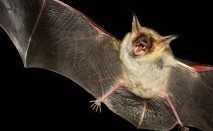
Category: Mammals

Also known as the Eurasian wild pig, these versatile omnivores are native to Eurasia, North Africa and the Greater Sunda Islands. Humans, however, have helped to spread them well beyond their native lands, and they are now one of the widest ranging mammals in the world. They live in matriarchal societies comprised of genetically related females and their young (male and female) - adult males are generally solitary outside of breeding seasons. They are the ancestor of most domestic pigs.

The age-defying Brandt’s bat
In most mammals, larger size correlates with longer lifespan, but that is not the case with the Brandt’s bat, who can live up to 41 years and weigh less than 0.28 ounces! These bats resemble larger, longer-lived mammals in that they mature slowly and have fewer offspring – but the size difference is dramatic: a female Bonobo lives for approximately 40 years as well, but she outweighs the Brandt’s bat by a factor of 3,771! Oddly enough, it is suspected that the mutated gene that causes the bat’s dwarfish size is the same one that leads to its long lifespan. Studying animals with unusual longevity like the Brandt’s bat does more than just satisfy our curiosity, it could lead to longer, healthier lifespans for humans and other animals!
Learn more >>
 Discover Animals is a web-based educational resource offered by the NAIA
Discover Animals is a web-based educational resource offered by the NAIA